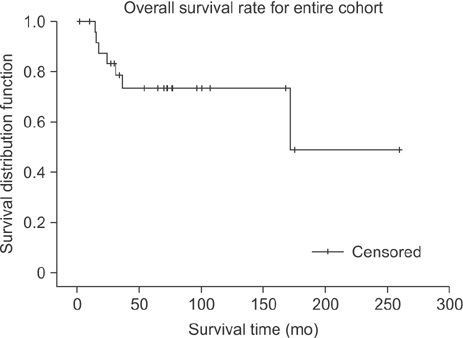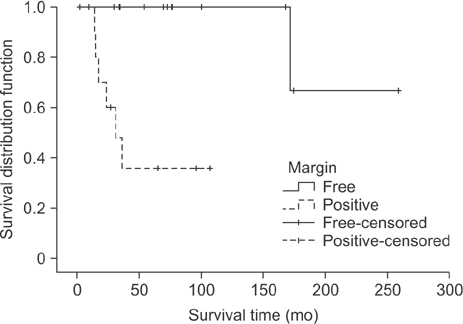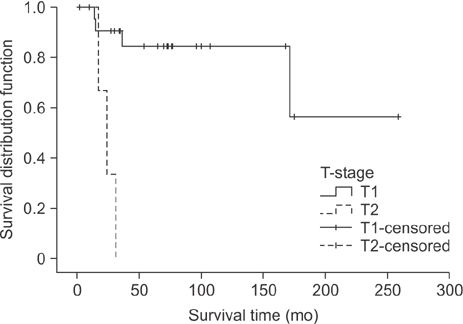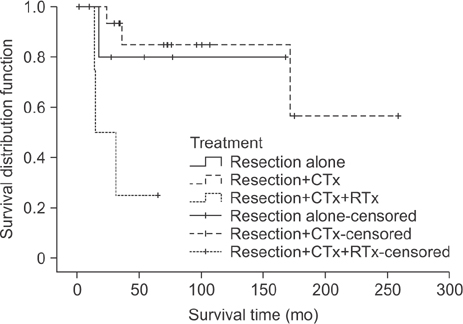J Korean Assoc Oral Maxillofac Surg.
2017 Oct;43(5):312-317. 10.5125/jkaoms.2017.43.5.312.
Osteosarcoma of the jaws in Koreans: analysis of 26 cases
- Affiliations
-
- 1Department of Oral and Maxillofacial Surgery, Yonsei University College of Dentistry, Seoul, Korea. kimoms@yuhs.ac
- 2Oral Cancer Research Institute, Yonsei University College of Dentistry, Seoul, Korea.
- 3Colonical War Memorial Hospital, Ministry of Health, Suva, Fiji.
- KMID: 2393596
- DOI: http://doi.org/10.5125/jkaoms.2017.43.5.312
Abstract
OBJECTIVES
In order to assess clinical behavior, response to treatment, and factors influencing prognosis of Korean patients with osteosarcoma of the jaws (OSJ).
MATERIALS AND METHODS
A retrospective study of clinical, and pathological records of 26 patients with OSJ treated at the Department of Oral and Maxillofacial Surgery in Yonsei University Dental Hospital from 1990 to March 2017.
RESULTS
Of 26 patients, there were 9 men (34.6%) and 17 women (65.4%). Twenty-one of 26 patients had osteosarcoma of the mandible, and 5 of 26 patients had osteosarcoma of the maxilla. The histopathology of OSJ is highly variable, ranging from chondroblastic type (6 out of 26), osteoblastic type (10 out of 26), fibroblastic type (2 out of 26), to the rare variants like mixed type, small cell osteosarcoma types and more. All patients underwent gross total excision and only a few patients underwent neoadjuvant chemotherapy. Postoperative chemotherapy was given to most of the patients as adjuvant treatment or in combination with radiotherapy. The overall survival rate was 73.1% with an overall 2-year survival rate of 83.3%. The overall 5-,10-,15-year survival rates in this study were 73.5%, 73.5%, 49%, respectively. Using Kaplan-Meier analysis with log rank tests, the size of tumor (T-stage), and resection margins were found to affect the survival rate significantly. The chemotherapy was not significantly associated with improved survival rate.
CONCLUSION
Surgical resection with a clear margin is the most important factor in disease survival. The role of chemotherapy and radiotherapy in OSJ remains controversial, and deserves further studies.
Keyword
MeSH Terms
Figure
Cited by 1 articles
-
Carbon-ion radiotherapy in osteosarcoma of the mandible: a case report
Tae-Wook Ha, Slmaro Park, Min Yeong Youn, Dong Wook Kim, Hyung Jun Kim
J Korean Assoc Oral Maxillofac Surg. 2021;47(4):315-320. doi: 10.5125/jkaoms.2021.47.4.315.
Reference
-
1. Garrington GE, Scofield HH, Cornyn J, Hooker SP. Osteosarcoma of the jaws. Analysis of 56 cases. Cancer. 1967; 20:377–391.2. Russ JE, Jesse RH. Management of osteosarcoma of the maxilla and mandible. Am J Surg. 1980; 140:572–576.
Article3. Rosen G, Caparros B, Huvos AG, Kosloff C, Nirenberg A, Cacavio A, et al. Preoperative chemotherapy for osteogenic sarcoma: selection of postoperative adjuvant chemotherapy based on the response of the primary tumor to preoperative chemotherapy. Cancer. 1982; 49:1221–1230.
Article4. Rosen G. Preoperative (neoadjuvant) chemotherapy for osteogenic sarcoma: a ten year experience. Orthopedics. 1985; 8:659–664.
Article5. Smeele LE, Kostense PJ, van der, Snow GB. Effect of chemotherapy on survival of craniofacial osteosarcoma: a systematic review of 201 patients. J Clin Oncol. 1997; 15:363–367.
Article6. Kassir RR, Rassekh CH, Kinsella JB, Segas J, Carrau RL, Hokanson JA. Osteosarcoma of the head and neck: meta-analysis of nonrandomized studies. Laryngoscope. 1997; 107:56–61.
Article7. Carrle D, Bielack SS. Current strategies of chemotherapy in osteosarcoma. Int Orthop. 2006; 30:445–451.
Article8. August M, Magennis P, Dewitt D. Osteogenic sarcoma of the jaws: factors influencing prognosis. Int J Oral Maxillofac Surg. 1997; 26:198–204.
Article9. Oda D, Bavisotto LM, Schmidt RA, McNutt M, Bruckner JD, Conrad EU 3rd, et al. Head and neck osteosarcoma at the University of Washington. Head Neck. 1997; 19:513–523.
Article10. Lee RJ, Arshi A, Schwartz HC, Christensen RE. Characteristics and prognostic factors of osteosarcoma of the jaws: a retrospective cohort study. JAMA Otolaryngol Head Neck Surg. 2015; 141:470–477.
Article11. Fernandes R, Nikitakis NG, Pazoki A, Ord RA. Osteogenic sarcoma of the jaw: a 10-year experience. J Oral Maxillofac Surg. 2007; 65:1286–1291.
Article12. Kämmerer PW, Shabazfar N, Vorkhshori Makoie N, Moergel M, Al-Nawas B. Clinical, therapeutic and prognostic features of osteosarcoma of the jaws: experience of 36 cases. J Craniomaxillofac Surg. 2012; 40:541–548.
Article13. Ferrari D, Codecà C, Battisti N, Broggio F, Crepaldi F, Violati M, et al. Multimodality treatment of osteosarcoma of the jaw: a single institution experience. Med Oncol. 2014; 31:171.
Article14. Smith RB, Apostolakis LW, Karnell LH, Koch BB, Robinson RA, Zhen W, et al. National Cancer Data Base report on osteosarcoma of the head and neck. Cancer. 2003; 98:1670–1680.
Article15. Jasnau S, Meyer U, Potratz J, Jundt G, Kevric M, Joos UK, et al. Craniofacial osteosarcoma: experience of the cooperative German-Austrian-Swiss osteosarcoma study group. Oral Oncol. 2008; 44:286–294.16. Canadian Society of Otolaryngology-Head and Neck Surgery Oncology Study Group. Osteogenic sarcoma of the mandible and maxilla: a Canadian review (1980-2000). J Otolaryngol. 2004; 33:139–144.17. Granowski-LeCornu M, Chuang SK, Kaban LB, August M. Osteosarcoma of the jaws: factors influencing prognosis. J Oral Maxillofac Surg. 2011; 69:2368–2375.
Article18. Ajagbe HA, Junaid TA, Daramola JO. Osteogenic sarcoma of the jaw in an African community: report of twenty-one cases. J Oral Maxillofac Surg. 1986; 44:104–106.
Article19. Kragh LV, Dahlin DC, Erich JB. Osteogenic sarcoma of the jaws and facial bones. Am J Surg. 1958; 96:496–505.
Article20. Lee YB, Kim NK, Kim JY, Kim HJ. Low-grade osteosarcoma arising from cemento-ossifying fibroma: a case report. J Korean Assoc Oral Maxillofac Surg. 2015; 41:48–51.
Article21. Hauben EI, Weeden S, Pringle J, Van Marck EA, Hogendoorn PC. Does the histological subtype of high-grade central osteosarcoma influence the response to treatment with chemotherapy and does it affect overall survival? A study on 570 patients of two consecutive trials of the European Osteosarcoma Intergroup. Eur J Cancer. 2002; 38:1218–1225.
Article22. Paparella ML, Olvi LG, Brandizzi D, Keszler A, Santini-Araujo E, Cabrini RL. Osteosarcoma of the jaw: an analysis of a series of 74 cases. Histopathology. 2013; 63:551–557.
Article23. Smeele LE, Snow GB, van der Waal I. Osteosarcoma of the head and neck: meta-analysis of the nonrandomized studies. Laryngoscope. 1998; 108:946.
Article





